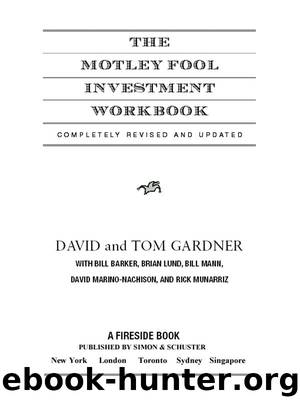The Motley Fool Investment Workbook by David & Tom Gardner

Author:David & Tom Gardner
Language: eng
Format: epub
Publisher: Simon & Schuster
Published: 2003-07-15T00:00:00+00:00
The company is consuming more cash than it is taking in. In 2001, cash flows were positive, by $5.7 million. But in 2002, they got loose with their receivables, let inventories spiral up, and ended up with negative cash flow of $4.62 million.
This should send flags and flares in the air and sound sirens. Negative operating cash flow is not necessarily the end of the world. At times, companies want to increase inventory. For example, a retail company has to increase its product count before Christmas. It doesn’t want to sell out of Elmo dolls, so it mass-produces them. And when the balance sheet for that quarter arrives, the company may show a tremendous rise in inventory, but it isn’t problematic. This is where your knowledge of the business comes into play. Not all of this stuff is quantitative.
All of that said, more often than not, rising receivables and inventory are signs of a problem, and you’ll want to avoid companies (particularly unproven companies) with negative cash flows from operating activities.
Other Sections on the Cash Flow Statement
The cash flow statement doesn’t end with operating activities. The two sections remaining on a cash flow statement represent investing and financing activities. We’ll take a quick look at them now.
Cash Flows from Investing Activities
This section contains the company’s investments in and sale of securities, joint business ventures, and capital equipment. We’ll focus here on the concept of free cash flow, which represents cash left over after a company has met its basic obligations. Free cash flow is what’s left over after all the necessary business expenses are funded—operations and purchases of plant, property, and equipment (a.k.a. capital expenditures). It is the money available to repurchase shares, pay down debt, or offer dividends. In some sense, it’s the amount of money that the company gives back to you, its owner, in one form or another. A major part of valuation work involves estimating a company’s sustainable cash flow, so this simple number is a good starting point for a valuation framework.
The basic formula for calculating free cash flow is
Free cash flow =
cash from operations − capital expenditures
Download
This site does not store any files on its server. We only index and link to content provided by other sites. Please contact the content providers to delete copyright contents if any and email us, we'll remove relevant links or contents immediately.
| Budgeting & Money Management | College & Education Costs |
| Credit Ratings & Repair | Retirement Planning |
The Compound Effect by Darren Hardy(8806)
Tools of Titans by Timothy Ferriss(8212)
Nudge - Improving Decisions about Health, Wealth, and Happiness by Thaler Sunstein(7613)
Win Bigly by Scott Adams(7094)
Deep Work by Cal Newport(6876)
Rich Dad Poor Dad by Robert T. Kiyosaki(6398)
Pioneering Portfolio Management by David F. Swensen(6226)
Principles: Life and Work by Ray Dalio(6201)
The Barefoot Investor by Scott Pape(5698)
Digital Minimalism by Cal Newport;(5661)
Grit by Angela Duckworth(5512)
The Slight Edge by Jeff Olson(5346)
Discipline Equals Freedom by Jocko Willink(5278)
The Motivation Myth by Jeff Haden(5154)
You Are a Badass at Making Money by Jen Sincero(4866)
The Four Tendencies by Gretchen Rubin(4544)
Eat That Frog! by Brian Tracy(4430)
The Confidence Code by Katty Kay(4187)
Bullshit Jobs by David Graeber(4094)
